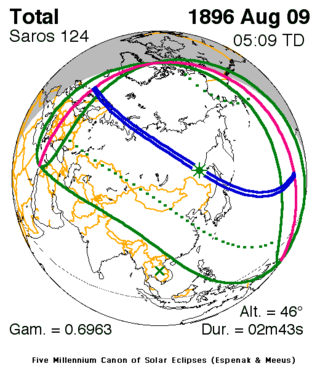Solar eclipse of August 9, 1896
| Solar eclipse of August 9, 1896 | |
|---|---|
| Type of eclipse | |
| Nature | Total |
| Gamma | 0.6964 |
| Magnitude | 1.0392 |
| Maximum eclipse | |
| Duration | 163 s (2 min 43 s) |
| Coordinates | 54°24′N 132°12′E / 54.4°N 132.2°E |
| Max. width of band | 182 km (113 mi) |
| Times (UTC) | |
| Greatest eclipse | 5:09:00 |
| References | |
| Saros | 124 (48 of 73) |
| Catalog # (SE5000) | 9272 |
A total solar eclipse occurred at the Moon's descending node of orbit on Sunday, August 9, 1896, with a magnitude of 1.0392. A solar eclipse occurs when the Moon passes between Earth and the Sun, thereby totally or partly obscuring the image of the Sun for a viewer on Earth. A total solar eclipse occurs when the Moon's apparent diameter is larger than the Sun's, blocking all direct sunlight, turning day into darkness. Totality occurs in a narrow path across Earth's surface, with the partial solar eclipse visible over a surrounding region thousands of kilometres wide. Occurring about 2.5 days before perigee (on August 11, 1896, at 18:30 UTC), the Moon's apparent diameter was larger.[1]
The path of totality was visible from parts of northern Norway, northern Sweden, the Russian Empire, and the Empire of Japan. A partial solar eclipse was also visible for much of Europe, Central Asia, East Asia, Northeast Asia, Alaska, and Greenland.
This event was the subject of the first organized eclipse expedition by the British Astronomical Association. A group of 165 amateur and professional astronomers sailed from Tilbury, England on July 25, heading toward Vadsø, Norway.[2] This expedition failed to produce any usable results as they were frustrated by the weather conditions at the time of the eclipse.[3] However, a smaller expedition to Novaya Zemlya on Sir George Baden-Powell's yacht Otario met with success.[2]
Gallery
[edit]Eclipse details
[edit]Shown below are two tables displaying details about this particular solar eclipse. The first table outlines times at which the moon's penumbra or umbra attains the specific parameter, and the second table describes various other parameters pertaining to this eclipse.[4]
| Event | Time (UTC) |
|---|---|
| First Penumbral External Contact | 1896 August 09 at 02:43:20.8 UTC |
| First Umbral External Contact | 1896 August 09 at 03:52:06.8 UTC |
| First Central Line | 1896 August 09 at 03:53:08.3 UTC |
| First Umbral Internal Contact | 1896 August 09 at 03:54:10.1 UTC |
| Equatorial Conjunction | 1896 August 09 at 04:37:13.0 UTC |
| Ecliptic Conjunction | 1896 August 09 at 05:01:41.9 UTC |
| Greatest Duration | 1896 August 09 at 05:08:37.2 UTC |
| Greatest Eclipse | 1896 August 09 at 05:09:00.1 UTC |
| Last Umbral Internal Contact | 1896 August 09 at 06:24:07.8 UTC |
| Last Central Line | 1896 August 09 at 06:25:11.8 UTC |
| Last Umbral External Contact | 1896 August 09 at 06:26:15.3 UTC |
| Last Penumbral External Contact | 1896 August 09 at 07:34:47.9 UTC |
| Parameter | Value |
|---|---|
| Eclipse Magnitude | 1.03918 |
| Eclipse Obscuration | 1.07989 |
| Gamma | 0.69635 |
| Sun Right Ascension | 09h18m02.6s |
| Sun Declination | +15°44'00.4" |
| Sun Semi-Diameter | 15'46.9" |
| Sun Equatorial Horizontal Parallax | 08.7" |
| Moon Right Ascension | 09h19m10.6s |
| Moon Declination | +16°21'57.5" |
| Moon Semi-Diameter | 16'12.5" |
| Moon Equatorial Horizontal Parallax | 0°59'29.1" |
| ΔT | -5.8 s |
Eclipse season
[edit]This eclipse is part of an eclipse season, a period, roughly every six months, when eclipses occur. Only two (or occasionally three) eclipse seasons occur each year, and each season lasts about 35 days and repeats just short of six months (173 days) later; thus two full eclipse seasons always occur each year. Either two or three eclipses happen each eclipse season. In the sequence below, each eclipse is separated by a fortnight.
| August 9 Descending node (new moon) | August 23 Ascending node (full moon) |
|---|---|
 | |
| Total solar eclipse Solar Saros 124 | Partial lunar eclipse Lunar Saros 136 |
Related eclipses
[edit]Eclipses in 1896
[edit]- An annular solar eclipse on February 13.
- A partial lunar eclipse on February 28.
- A total solar eclipse on August 9.
- A partial lunar eclipse on August 23.
Metonic
[edit]- Preceded by: Solar eclipse of October 20, 1892
- Followed by: Solar eclipse of May 28, 1900
Tzolkinex
[edit]- Preceded by: Solar eclipse of June 28, 1889
- Followed by: Solar eclipse of September 21, 1903
Half-Saros
[edit]- Preceded by: Lunar eclipse of August 3, 1887
- Followed by: Lunar eclipse of August 15, 1905
Tritos
[edit]- Preceded by: Solar eclipse of September 8, 1885
- Followed by: Solar eclipse of July 10, 1907
Solar Saros 124
[edit]- Preceded by: Solar eclipse of July 29, 1878
- Followed by: Solar eclipse of August 21, 1914
Inex
[edit]- Preceded by: Solar eclipse of August 29, 1867
- Followed by: Solar eclipse of July 20, 1925
Triad
[edit]- Preceded by: Solar eclipse of October 9, 1809
- Followed by: Solar eclipse of June 11, 1983
Solar eclipses of 1895–1899
[edit]This eclipse is a member of a semester series. An eclipse in a semester series of solar eclipses repeats approximately every 177 days and 4 hours (a semester) at alternating nodes of the Moon's orbit.[5]
The partial solar eclipses on March 26, 1895 and September 18, 1895 occur in the previous lunar year eclipse set, and the partial solar eclipse on December 13, 1898 occurs in the next lunar year eclipse set.
| Solar eclipse series sets from 1895 to 1899 | ||||||
|---|---|---|---|---|---|---|
| Descending node | Ascending node | |||||
| Saros | Map | Gamma | Saros | Map | Gamma | |
| 114 | August 20, 1895 Partial | 1.3911 | 119 | February 13, 1896 Annular | −0.9220 | |
| 124 | August 9, 1896 Total | 0.6964 | 129 | February 1, 1897 Annular | −0.1903 | |
| 134 | July 29, 1897 Annular | −0.0640 | 139 | January 22, 1898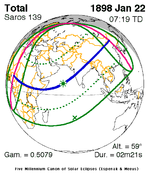 Total | 0.5079 | |
| 144 | July 18, 1898 Annular | −0.8546 | 149 | January 11, 1899 Partial | 1.1558 | |
Saros 124
[edit]This eclipse is a part of Saros series 124, repeating every 18 years, 11 days, and containing 73 events. The series started with a partial solar eclipse on March 6, 1049. It contains total eclipses from June 12, 1211 through September 22, 1968, and a hybrid eclipse on October 3, 1986. There are no annular eclipses in this set. The series ends at member 73 as a partial eclipse on May 11, 2347. Its eclipses are tabulated in three columns; every third eclipse in the same column is one exeligmos apart, so they all cast shadows over approximately the same parts of the Earth.
The longest duration of totality was produced by member 39 at 5 minutes, 46 seconds on May 3, 1734. All eclipses in this series occur at the Moon’s descending node of orbit.[6]
| Series members 43–64 occur between 1801 and 2200: | ||
|---|---|---|
| 43 | 44 | 45 |
 June 16, 1806 |  June 26, 1824 |  July 8, 1842 |
| 46 | 47 | 48 |
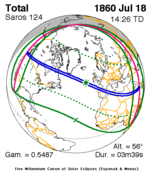 July 18, 1860 | 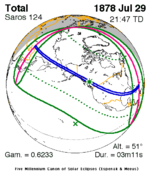 July 29, 1878 |  August 9, 1896 |
| 49 | 50 | 51 |
 August 21, 1914 |  August 31, 1932 |  September 12, 1950 |
| 52 | 53 | 54 |
 September 22, 1968 |  October 3, 1986 |  October 14, 2004 |
| 55 | 56 | 57 |
 October 25, 2022 |  November 4, 2040 |  November 16, 2058 |
| 58 | 59 | 60 |
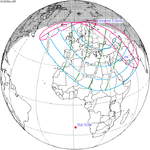 November 26, 2076 |  December 7, 2094 |  December 19, 2112 |
| 61 | 62 | 63 |
 December 30, 2130 |  January 9, 2149 | 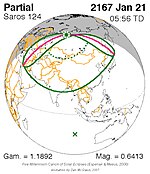 January 21, 2167 |
| 64 | ||
 January 31, 2185 | ||
Metonic series
[edit]The metonic series repeats eclipses every 19 years (6939.69 days), lasting about 5 cycles. Eclipses occur in nearly the same calendar date. In addition, the octon subseries repeats 1/5 of that or every 3.8 years (1387.94 days). All eclipses in this table occur at the Moon's descending node.
| 22 eclipse events between March 16, 1866 and August 9, 1953 | ||||
|---|---|---|---|---|
| March 16–17 | January 1–3 | October 20–22 | August 9–10 | May 27–29 |
| 108 | 110 | 112 | 114 | 116 |
 March 16, 1866 |  August 9, 1877 |  May 27, 1881 | ||
| 118 | 120 | 122 | 124 | 126 |
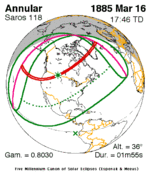 March 16, 1885 |  January 1, 1889 |  October 20, 1892 |  August 9, 1896 |  May 28, 1900 |
| 128 | 130 | 132 | 134 | 136 |
 March 17, 1904 |  January 3, 1908 |  October 22, 1911 |  August 10, 1915 |  May 29, 1919 |
| 138 | 140 | 142 | 144 | 146 |
 March 17, 1923 |  January 3, 1927 |  October 21, 1930 |  August 10, 1934 |  May 29, 1938 |
| 148 | 150 | 152 | 154 | |
 March 16, 1942 |  January 3, 1946 |  October 21, 1949 | 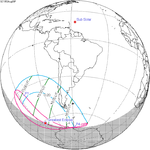 August 9, 1953 | |
Tritos series
[edit]This eclipse is a part of a tritos cycle, repeating at alternating nodes every 135 synodic months (≈ 3986.63 days, or 11 years minus 1 month). Their appearance and longitude are irregular due to a lack of synchronization with the anomalistic month (period of perigee), but groupings of 3 tritos cycles (≈ 33 years minus 3 months) come close (≈ 434.044 anomalistic months), so eclipses are similar in these groupings.
| Series members between 1801 and 2200 | ||||
|---|---|---|---|---|
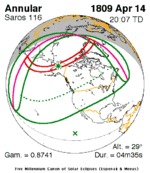 April 14, 1809 (Saros 116) |  March 14, 1820 (Saros 117) |  February 12, 1831 (Saros 118) | 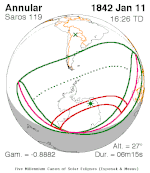 January 11, 1842 (Saros 119) |  December 11, 1852 (Saros 120) |
 November 11, 1863 (Saros 121) |  October 10, 1874 (Saros 122) |  September 8, 1885 (Saros 123) |  August 9, 1896 (Saros 124) |  July 10, 1907 (Saros 125) |
 June 8, 1918 (Saros 126) |  May 9, 1929 (Saros 127) |  April 7, 1940 (Saros 128) |  March 7, 1951 (Saros 129) |  February 5, 1962 (Saros 130) |
 January 4, 1973 (Saros 131) |  December 4, 1983 (Saros 132) |  November 3, 1994 (Saros 133) |  October 3, 2005 (Saros 134) |  September 1, 2016 (Saros 135) |
 August 2, 2027 (Saros 136) |  July 2, 2038 (Saros 137) |  May 31, 2049 (Saros 138) |  April 30, 2060 (Saros 139) |  March 31, 2071 (Saros 140) |
 February 27, 2082 (Saros 141) |  January 27, 2093 (Saros 142) |  December 29, 2103 (Saros 143) |  November 27, 2114 (Saros 144) |  October 26, 2125 (Saros 145) |
 September 26, 2136 (Saros 146) |  August 26, 2147 (Saros 147) | 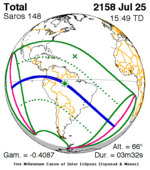 July 25, 2158 (Saros 148) |  June 25, 2169 (Saros 149) |  May 24, 2180 (Saros 150) |
 April 23, 2191 (Saros 151) | ||||
Inex series
[edit]This eclipse is a part of the long period inex cycle, repeating at alternating nodes, every 358 synodic months (≈ 10,571.95 days, or 29 years minus 20 days). Their appearance and longitude are irregular due to a lack of synchronization with the anomalistic month (period of perigee). However, groupings of 3 inex cycles (≈ 87 years minus 2 months) comes close (≈ 1,151.02 anomalistic months), so eclipses are similar in these groupings.
| Series members between 1801 and 2200 | ||
|---|---|---|
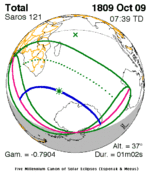 October 9, 1809 (Saros 121) | 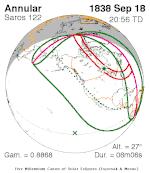 September 18, 1838 (Saros 122) |  August 29, 1867 (Saros 123) |
 August 9, 1896 (Saros 124) |  July 20, 1925 (Saros 125) |  June 30, 1954 (Saros 126) |
 June 11, 1983 (Saros 127) |  May 20, 2012 (Saros 128) |  April 30, 2041 (Saros 129) |
 April 11, 2070 (Saros 130) |  March 21, 2099 (Saros 131) |  March 1, 2128 (Saros 132) |
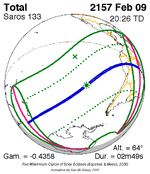 February 9, 2157 (Saros 133) |  January 20, 2186 (Saros 134) | |
References
[edit]- ^ "Moon Distances for London, United Kingdom, England". timeanddate. Retrieved 27 August 2024.
- ^ a b Marriott, R. A. (June 1991). "Norway 1896: the BAA's first organised eclipse expedition". Journal of the British Astronomical Association. 101 (3): 162–170. Bibcode:1991JBAA..101..162M.
- ^ "Expedition for the Observation of the Total Solar Eclipse, August 9th, 1896". Memoirs of the British Astronomical Association. 6: 1–4. 1898. Bibcode:1898MmBAA...6....1.
- ^ "Total Solar Eclipse of 1896 Aug 09". EclipseWise.com. Retrieved 27 August 2024.
- ^ van Gent, R.H. "Solar- and Lunar-Eclipse Predictions from Antiquity to the Present". A Catalogue of Eclipse Cycles. Utrecht University. Retrieved 6 October 2018.
- ^ "NASA - Catalog of Solar Eclipses of Saros 124". eclipse.gsfc.nasa.gov.
External links
[edit]- NASA graphics
- Corona and Coronet: Being a narrative of the Amherst Eclipse Expedition to Japan, in Mr. James's Schooner-Yacht Coronet, to Observe the Sun's Total Obscuration, 9th August, 1896, by Mabel Loomis Todd, Houghton, Mifflin and Company, publishers, 1898
- Mabel Loomis Todd (1900). Total Eclipses of the Sun. Little, Brown.
- Solar eclipse of August 9, 1896 in Russia Archived August 9, 2009, at the Wayback Machine


 French
French Deutsch
Deutsch